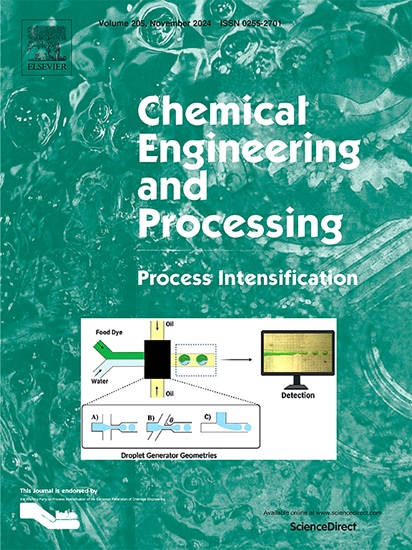Numerical and experimental analysis of droplet dynamics in constricted milli and microchannels
IF 3.8
3区 工程技术
Q3 ENERGY & FUELS
Chemical Engineering and Processing - Process Intensification
Pub Date : 2025-07-13
DOI:10.1016/j.cep.2025.110448
引用次数: 0
Abstract
This study investigates the dynamics of droplets flowing through constricted channels at milli and microscales using a combination of experimental and numerical approaches. Experiments were conducted in a 3D-printed millichannel with three immiscible fluid pairs, spanning a wide range of viscosity ratios between dispersed and continuous phases (10–2<X<102) and Capillary numbers of the continuous phase (10-4<Cac<10-1). Numerical simulations, employing the Volume of Fluid (VOF) methodology and performed with Ansys FLUENT® 2021 R2, complemented the experiments by exploring two geometrical scales: milli (aspect ratio: 5:3 at the inlet channel; 1:3 in the constricted region) and micro (aspect ratio: 5:1.5 before the contraction; 1:1.5 after contraction). For milliscale simulations, X ranged from 10–1 to 102 and Cac from 10–3 to 10–1, while in microscale simulations, 10–2<X<102 and 10–4<Cac<100. A comprehensive analysis of velocity profiles, film thickness, and droplet deformation was conducted numerically. Strong agreement between experimental and numerical results for average droplet velocity and length within the constricted region validated the computational model’s robustness. This work elucidates the influence of Cac and X on droplet deformation, velocity, and film thickness, providing valuable insights into the optimization of multiphase microfluidic systems.

微孔道和微孔道中液滴动力学的数值和实验分析
本研究采用实验和数值相结合的方法,研究了微尺度和微米尺度下液滴在狭窄通道中流动的动力学。实验在3d打印的微通道中进行,其中有三种不混相流体对,分散相和连续相的粘度比(10-2<X<102)和连续相的毛细管数(10-4<Cac<10-1)范围很广。采用流体体积(VOF)方法并使用Ansys FLUENT®2021 R2进行的数值模拟,通过探索两种几何尺度来补充实验:毫米(宽高比:5:3)在进口通道;收缩区1:3)和微(缩前长宽比:5:1.5;收缩后1:1.5)。对于毫尺度模拟,X的范围从10-1到102,Cac的范围从10-3到10-1,而在微尺度模拟中,10-2<X<;102和10-4<;Cac<100。对速度分布、膜厚和液滴变形进行了数值分析。压缩区域内平均液滴速度和长度的实验结果与数值结果吻合较好,验证了计算模型的鲁棒性。这项工作阐明了Cac和X对液滴变形、速度和膜厚度的影响,为多相微流体系统的优化提供了有价值的见解。
本文章由计算机程序翻译,如有差异,请以英文原文为准。
求助全文
约1分钟内获得全文
求助全文
来源期刊
CiteScore
7.80
自引率
9.30%
发文量
408
审稿时长
49 days
期刊介绍:
Chemical Engineering and Processing: Process Intensification is intended for practicing researchers in industry and academia, working in the field of Process Engineering and related to the subject of Process Intensification.Articles published in the Journal demonstrate how novel discoveries, developments and theories in the field of Process Engineering and in particular Process Intensification may be used for analysis and design of innovative equipment and processing methods with substantially improved sustainability, efficiency and environmental performance.

 求助内容:
求助内容: 应助结果提醒方式:
应助结果提醒方式:


